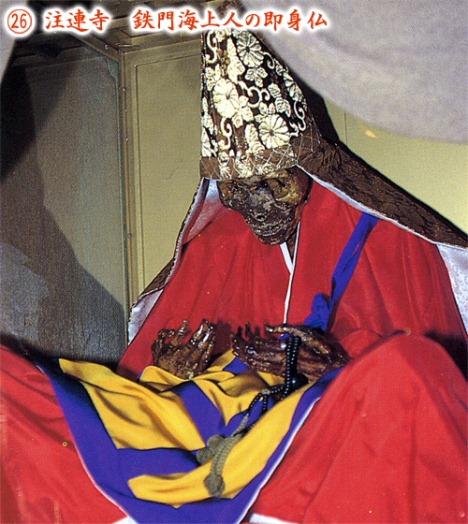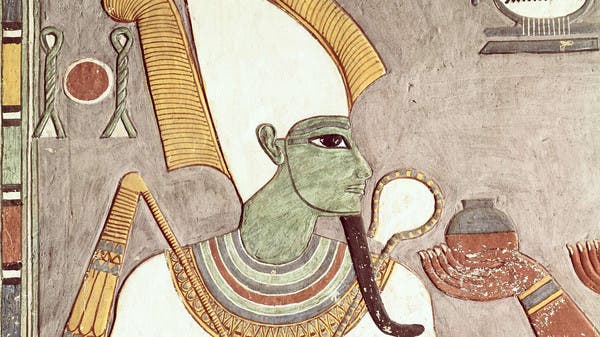Saturday, January 31, 2015
Friday, January 30, 2015
Thursday, January 29, 2015
Sokushinbutsu: Self Mummification
Scattered throughout Northern Japan around the Yamagata
Prefecture are two dozen mummified Japanese monks known as Sokushinbutsu, who
caused their own deaths in a way that resulted in their mummification. The
practice was first pioneered by a priest named Kuukai over 1000 years ago at
the temple complex of Mount Koya, in Wakayama prefecture. Kuukai was founder of
the Shingon sect of Buddhism, which is the sect that came up with the idea of
enlightenment through physical punishment. A successful mummification took
upwards of ten years. It is believed that many hundreds of monks tried, but
only between 16 and 24 such mummifications have been discovered to date.
The elaborate process started with 1,000 days of eating a
special diet consisting only of nuts and seeds, while taking part in a regimen
of rigorous physical activity that stripped them of their body fat. They then
ate only bark and roots for another thousand days and began drinking a
poisonous tea made from the sap of the Urushi tree, normally used to lacquer
bowls.
 This caused vomiting and a rapid loss of bodily fluids, and
most importantly, it made the body too poisonous to be eaten by maggots.
Finally, a self-mummifying monk would lock himself in a stone tomb barely
larger than his body, where he would not move from the lotus position. His only
connection to the outside world was an air tube and a bell. Each day he rang a
bell to let those outside know that he was still alive.
This caused vomiting and a rapid loss of bodily fluids, and
most importantly, it made the body too poisonous to be eaten by maggots.
Finally, a self-mummifying monk would lock himself in a stone tomb barely
larger than his body, where he would not move from the lotus position. His only
connection to the outside world was an air tube and a bell. Each day he rang a
bell to let those outside know that he was still alive.
When the bell stopped ringing, the tube was removed and the
tomb sealed. After the tomb was sealed, the other monks in the temple would
wait another 1,000 days, and open the tomb to see if the mummification was
successful. If the monk had been successfully mummified, they were immediately
seen as a Buddha and put in the temple for viewing. Usually, though, there was
just a decomposed body.
The mummies also possess the accessories they had prior to
death. However, their eyes have been removed. Even so, they are considered able
to see into the souls of the living and be able to perceive reality perfectly.
The practice is now outlawed by the government of Japan and
not practiced today by any Buddhist sect.
Wednesday, January 21, 2015
Unlocking Scrolls Preserved in Eruption of Vesuvius, Using X-Ray Beams
By NICHOLAS WADE
The library is that of a villa in Herculaneum, a town that
was destroyed in A.D. 79 by the eruption of Mount Vesuvius that obliterated
nearby Pompeii. Though Pompeii was engulfed by lava, a mix of superhot gases
and ash swept over Herculaneum, preserving the documents in a grand villa that probably
belonged to the family of Lucius Calpurnius Piso Caesoninus, the father-in-law
of Julius Caesar.
Though the hot gases did not burn the many papyrus rolls in
the villa’s library, they turned them into cylinders of carbonized plant
material. Many attempts have been made to unroll the carbonized scrolls since
they were excavated in 1752.
Prehistoric tree stumps on a beach in Borth, Wales, from a
forest first flooded about 5,000 years ago, after the last ice age.A Sunken
Kingdom Re-emergesJUNE 23, 2014
Pompeii's decline has captured the attention of the European
Union, which began an effort in February aiming to balance preservation with
accessibility to tourists.Italian Bureaucracy Threatens Pompeii
But all were highly destructive, and scholars eventually
decided to leave the scrolls alone in the hope that better methods would be
invented. More than 300 scrolls survive more or less intact, with many more
fragments.
The archaeological excavations of Herculaneum in the villa
dei Papiri, Italy. Credit Splash News, via Corbis Researchers led by Vito Mocella, of the Institute for
Microelectronics and Microsystems in Naples, Italy, now say that for the first
time, they can read letters inside the scrolls without unrolling them. Using a
laserlike beam of X-rays from the European Synchrotron in Grenoble, France,
they were able to pick up the very slight contrast between the carbonized
papyrus fibers and the ancient ink, soot-based and also made of carbon.
The contrast has allowed them to recognize individual Greek
letters from the interior of the roll, Dr. Mocella’s team reported on Tuesday
in the journal Nature Communications. “At least we know there are techniques
able to read inside the papyri, finally,” Dr. Mocella said in an interview. His
team is considering several ways to refine the power of their technique.
“If the technology is perfected, it will be a real leap
forward,” said Richard Janko, a classical scholar at the University of Michigan
who has translated some of the few scrolls that can be read.
The research team look upon the Herculaneum Scrolls during a
sample installation. Credit J. Delattre
The Mocella team’s work is the second recent advance in
reading the Herculaneum scrolls. In 2009, Brent Seales, a computer scientist at
the University of Kentucky, succeeded in delineating the physical structure of
a Herculaneum scroll by X-ray-computed tomography, a process similar to a CT
scan. The layers of papyrus wound up inside the scroll are highly ruffled and
irregular because the hot gases liberated all the water from the fibers as well
as carbonizing them.
The Mocella team’s method visualizes letters free floating
inside the scroll, but each letter will need to be assigned to its correct
place on Dr. Seales’s surface before the letters can form words. Dr. Seales and
Dr. Mocella worked with Herculaneum scrolls acquired by Napoleon in 1802 and
belonging to the Institut de France in Paris.
“This is absolutely a major step forward,” Dr. Seales said
of the Mocella report. “These guys are focused on showing the imagery with best
contrast. But to really read the papyrus, you need to untangle its surface,
which is the active area of my work.”
The Herculaneum Papyrus scroll. Credit D.
Delattre/Bibliothèque de l'Institut de France
Classical scholars are particularly interested in the
physicists’ progress because of the chance of uncovering lost works of Latin
and Greek literature. Piso’s grand villa — which is the model for the Getty
Villa, part of the J. Paul Getty Museum in Los Angeles — is thought to have
probably contained a large and wide-ranging library, much of which may still
exist in unexcavated portions of the building.
“It would have been odd for a villa of this sort not to have
had a major library,” Dr. Janko said. “So this technology, when perfected, does
open the way to rediscovering a lot more ancient literature.”
The scrolls that have been opened pertain mostly to Greek
philosophy and contain several works by Epicurus and his adherent Philodemus.
But the library may also have had a Latin section. This could contain some of
the many lost works of Roman history and literature. Even the texts of known
works would be of great interest.
“For a scholar, it would be wonderful to have a manuscript
of Virgil written in his lifetime, because what we have are medieval
manuscripts which have suffered many changes at the hands of copyists,” said
David Sider, a professor of classics at New York University.
Wednesday, January 14, 2015
Wednesday, January 7, 2015
Test and Projects
Remember students have their projects due next week.
5th Grade is due on Thursday, 1/15/15.
6th Grade is due Monday, 1/12/15.
6th Grade will also have a test on Tuesday 1/13/15.
Africa Study Guide
5th Grade is due on Thursday, 1/15/15.
6th Grade is due Monday, 1/12/15.
6th Grade will also have a test on Tuesday 1/13/15.
Africa Study Guide
Sunday, January 4, 2015
Two ancient tombs discovered in Egypt
Al Arabiya News
Sunday, 4 January 2015
Two ancient tombs were discovered in Egypt on Sunday, with one representing a symbolic burial site of the god Osiris while another is claimed to be a previously unknown pharaonic tomb.
The paper said Osiris’ tomb was found complete with multiple shafts and chambers at Al-Gorna necropolis on Luxor’s west bank, Ahram Online reported.
Antiquities Minister Mamdouh Eldamaty, speaking to the daily, hailed the discovery as important as the tomb was a small version of the design of the Osirion found in Abydos in the Upper Egypt city of Sohag.
The tomb, which consists of a large hall supported with five pillars, can be dated to the 25th Dynasty, the daily quoted Abdel Hakim Karar, head of Antiquities of Upper Egypt, as saying.
The paper quoted María Milagros Álvarez Sosa, head of the mission, as saying that part of the tomb was initially discovered by archaeologist Philippe Virey in the 1880s and that some attempts were made to sketch out the main structure in the 20th century.
Osiris was a pivotal god to the ancient Egyptians and was usually identified as the god of the afterlife, the underworld and the dead.
Tomb of unknown queen found
Meanwhile, Czech archaeologists have unearthed the tomb of a previously unknown queen believed to have been the wife of Pharaoh Neferefre who ruled 4,500 years ago, Agence France-Presse reported officials as saying on Sunday.
The tomb was discovered in Abu Sir, an Old Kingdom necropolis southwest of Cairo where there are several pyramids dedicated to pharaohs of the Fifth Dynasty, including Neferefre.
The name of his wife had not been known before the find, Antiquities Minister Mamdouh al-Damaty said in a statement.
He identified her as Khentakawess, saying that for the “first time we have discovered the name of this queen who had been unknown before the discovery of her tomb.”
That would make her Khentakawess III, as two previous queens with the same name have already been identified.
Her name and rank had been inscribed on the inner walls of the tomb, probably by the builders, Damaty said.
“This discovery will help us shed light on certain unknown aspects of the Fifth Dynasty, which along with the Fourth Dynasty, witnessed the construction of the first pyramids,” he added.
Miroslav Barta, who heads the Czech Institute of Egyptology mission who made the discovery, said the tomb was found in Neferefre’s funeral complex.
“This makes us believe that the queen was his wife,” Barta said, according to the statement.
An official at the antiquities ministry said the tomb dated from the middle of the Fifth Dynasty (2994-2345 BC).
Archaeologists also found around 30 utensils, 24 made of limestone and four of copper, the statement added.
(With AFP)
Last Update: Sunday, 4 January 2015 KSA 21:07 - GMT 18:07
Subscribe to:
Posts (Atom)


